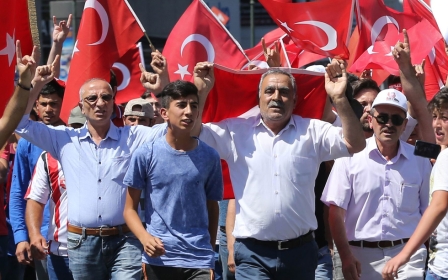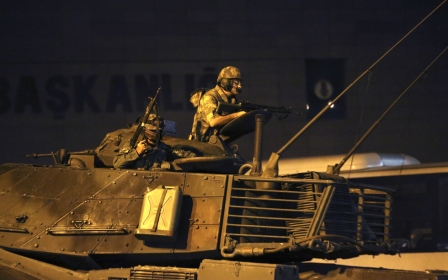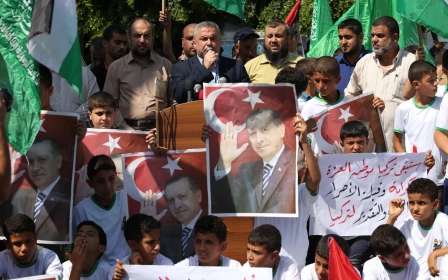Anatomy of a coup: One night in Turkey, and the battle for democracy

Istanbul, TURKEY – On Friday evening, as the sun began to set on Istanbul, the city’s iconic Bosphorus bridge was lit for the first time in the colours of another country’s flag - the French tricolor, in solidarity with those killed in Nice on Bastille Day.
Only hours later the bridge was coloured with the blood of Turkish civilians, who had died to defend their democracy during a night of bewildering events that are yet to be fully understood.
It was a night when a military faction sought to topple the president, a night which spiralled into confrontation, violence and eventually capitulation of the coup plotters in the space of a few hours.
At 10pm local time on Friday, live television images began to hint at what was to come. The Bosphorus bridge and Istanbul’s other bridge, the Fatih Sultan Mehmet, connecting its Asian and European sides, was blocked.
Reports started pouring in of fighter jets buzzing the capital Ankara.
Initial thoughts were immediately directed at a potential terrorism threat - something with which Turkey has become all too familiar. But this was different.
It wasn’t police or police special forces sealing off the bridges, but paramilitary gendermarie troops - a military force. For a country that has witnessed four military coups, the sight of soldiers on the streets never bodes well.
Then armoured vehicles rumbled into place, disgorging more heavilly armed troops, as fighter jets roared low across the sky.
The worst was confirmed moments later - at 11pm the Turkish prime minister Binali Yildirim connected to a television station via phone and announced that the government was facing a military coup.
Yildirim issued a call for people to resist. Reports of gunfire from various locations in Istanbul and Ankara began pouring in.
It soon became clear that the battles were being waged at locations classically considered vital during previous coups: the state broadcaster TRT in Ankara; the building housing the national intelligence organisation; the building hosting elite police forces - the only armed unit under the control of the Interior Ministry.
In Istanbul, the rebels headed straight for Ataturk airport. Then Taksim Square. And the bridges became no-go areas, effectively cutting the city in two.
Reports flooded in of fighter jets and helicopters opening fire on Ankara's parliament, and on the lavish, newly constructed presidential palace.
At about midnight, TRT went off air, only to come back with the presenter mechanically reading - reportedly at gunpoint - from a script stating that the military had taken control of the country.
Martial law and a curfew were declared.
The rebels called themselves the “Council for Peace in the Homeland” and their statement also went out on Turkey's military’s website, which soon crashed under the weight of traffic.
The head of Turkey's army, General Hulusi Akar, had reportedly been taken hostage in Ankara.
There was no sign, or word, of President Recep Tayyip Erdogan. A right-wing newspaper reported that he was on holiday in the Aegean resort town of Marmaris.
News began to spread that he was now on a plane but rumours abounded over his destination. Some couldn’t choose between Ankara and Istanbul. Others said he was fleeing the country and even headed to Germany to seek asylum.
Everything, it seemed, was going according to the rebels' plan.
But then came the defining moment of the night. Having lost control of the state broadcaster, and the capital and Istanbul seemingly in rebels hands, Erdogan used an iPhone video app to connect a private broadcaster.
The broadcaster he chose was CNN Turk, a Dogan Media Group venture.
Dogan has been under intense pressure by Erdogan’s government and party for years. In addition to astronomical fines, there were physical attacks on CNN's premises led by an AKP youth leader last year.
Nevertheless, a visibly shaken Erdogan called on the people to take to the streets and defend their democracy. He said this treason would not go unpunished.
"We will overcome this," Erdogan said, "There is no power higher than the power of the people."
"Go to the streets and give them their answer... Those who are responsible, we will give them the necessary punishment."
At about 1.30am - hours before dawn - the minarets of mosques of Istanbul began to blast out the call to prayer, urging people to get on the streets.
And in response, the people poured onto those streets. Various ministers began connecting to television stations, people marched on soldiers stationed at the bridges, airport and other venues - not only in Istanbul and Ankara, but all across the country.
In some places, such as the airport, the soldiers retreated. In others they opened fire on the people and blood was spilled.
The Bosphorus bridge saw some of the worst violence. Videos captured the sound of heavy gunfire as civilians marched towards the machine guns, shouting for Erdogan and declaring "God is great".
At least five people are known to have died on that march.
And in Ankara, an explosion rocked parliament as rebel tanks circled. The intelligence headquarters nearby came under intense attack as helicopters rained bullets from above.
Videos on social media showed crowds diving for cover as bursts of tracer fire ripped along the streets.
But only moments later it was silenced - a loyalist F16 pilot had shot it out of the sky.
And despite the violence and the danger the crowds kept coming; unarmed civilians using the force of numbers to swarm over tanks, making citizens' arrests of those inside and seizing the guns from their hands.
Videos again emerged of civilians taking on military hardware, standing on tanks from which rebels had fled, as the momentum of the coup swung in the favour of democracy.
In the intervening hours TRT was taken back from the putschists but they in turn occupied other broadcasters. Private broadcaster CNN Turk fell to the coup, before being retaken by protesters.
Videos emerged of soldiers being arrested by police in large numbers inside television stations, as the plot fell further into dissaray. Some videos showed harsh beatings administered to the soldiers of the coup.
Then images appeared of Erdogan at Istanbul’s Ataturk airport absent his usually enormous security detail and in the midst of the people.
He gave a televised news conference and refused to bow to the coup threat. The coup, he said, was the work of his one time and current nemesis, Fethullah Gulen.
In the early hours of the morning reports started emerging that the coup had been thwarted and control was being restored. The resistance came at a heavy price - 161 confirmed deaths among pro-government supporters, 104 among the rebels.
Thousands of other coup plotters were taken into custody.
In the early morning light, both Erdogan and Yildrim renewed their call for people stay on the streets, or at the very worst take to them in numbers again on Saturday evening to ward off further coup attempts.
Yildrim has been renewing his call all day but nothing has been heard or seen from Erdogan since his televised press conference at the airport. Reports said he was still there. A solitary Twitter post has been his communication today.
At 5pm on Saturday, Turkey’s parliament convened for an extraordinary session and all four political parties present made speeches condemning the coup and confirming their belief and backing for democracy.
And as the sun began to set 24 hours after the beginning of this day of days, it was almost guaranteed that people would be back on the streets in large numbers.
Only time will tell whether they will be peaceful and celebratory gatherings, or protests that will lead to further clashes with pockets of resistance by the coup plotters.
New MEE newsletter: Jerusalem Dispatch
Sign up to get the latest insights and analysis on Israel-Palestine, alongside Turkey Unpacked and other MEE newsletters
Middle East Eye delivers independent and unrivalled coverage and analysis of the Middle East, North Africa and beyond. To learn more about republishing this content and the associated fees, please fill out this form. More about MEE can be found here.




